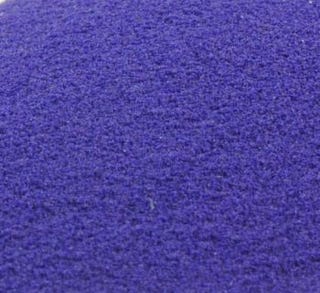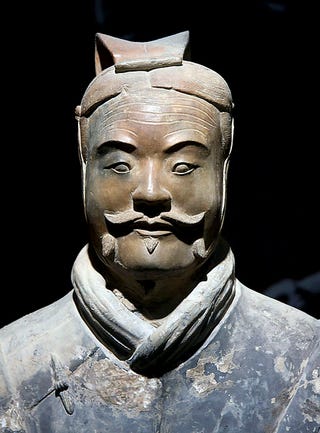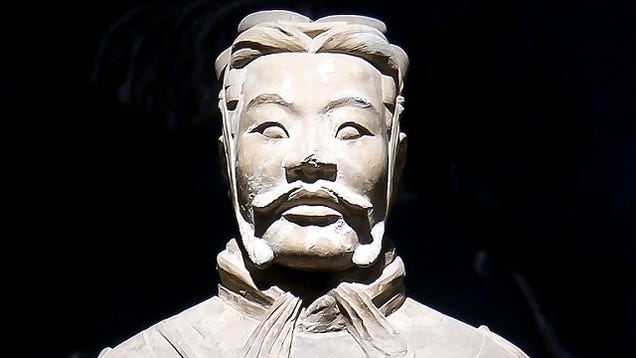
Han
purple is an ancient pigment that wasn't reconstructed by modern
chemists until 1992. After the chemists got done with it, it was the
physicists' turn. Han purple, they found, eliminates an entire dimension. It makes waves go two-dimensional!
The Chemistry of Han Purple
 You'll see
Han purple on the famous terracotta warriors surrounding the tomb of the
first emperor of China, or on ancient pottery and other works of art.
Where you won't see it is on anything made between 220 A.D. and 1992,
because after the pigment disappeared it took 1700 years to re-discover
it. Elisabeth FitzHugh, a conservator at the Smithsonian, pinned down
the chemical composition of the pigment and announced it was a barium
copper silicate. (The paper
describing the discovery is a fun read. It starts by pointing out the
inferiority of other ancient purple pigments, which tended to be closer
to red than purple. It also stresses that Tyrian purple, made from sea
snails, was a textile dye, not a pigment, and that it could range
anywhere from "reddish-blue to purplish-violet." Take that,
Phoenicians!)
You'll see
Han purple on the famous terracotta warriors surrounding the tomb of the
first emperor of China, or on ancient pottery and other works of art.
Where you won't see it is on anything made between 220 A.D. and 1992,
because after the pigment disappeared it took 1700 years to re-discover
it. Elisabeth FitzHugh, a conservator at the Smithsonian, pinned down
the chemical composition of the pigment and announced it was a barium
copper silicate. (The paper
describing the discovery is a fun read. It starts by pointing out the
inferiority of other ancient purple pigments, which tended to be closer
to red than purple. It also stresses that Tyrian purple, made from sea
snails, was a textile dye, not a pigment, and that it could range
anywhere from "reddish-blue to purplish-violet." Take that,
Phoenicians!)
Exactly how
some inventor stumbled on a way to make the pigment is still a matter
of debate. An early theory, not believed by many, is that the Chinese
learned how to make purple pigment from the Egyptians. Egyptian purple
pigment seems to be similar, but the chemical formulas don't add up —
Egyptians used calcium instead of barium. It's also not an easy process
to pass from one culture to another. To get the elements to melt
together, they have to be heated to about 850-1000 °C.
Most
researchers think that because it contains both silicon and barium Han
purple was a by-product of the glass-making process. Barium makes glass
shinier and cloudy, which means this pigment could be the work of early
alchemists trying to synthesize white jade.
Han Purple and the Third Dimension
Barium
copper-silicate doesn't just have archaeologists and chemists intrigued.
At normal temperatures, it's an insulator and is nonmagnetic. Along
with its many fine properties - prettiness, historical importance, a
hint of aristocratic style — barium copper-silicat has many electrons,
some of which spin up and some of which are spin down.
 Something
unusual happens as the temperature drops and as a magnetic field is
applied, although the temperature has to drop pretty far, going down to
between one and three degrees Kelvin, and the magnetic field has to be
about 800,000 times the strength of Earth's magnetic field. The results
are worth it — the electrons seem to merge, taking on one spin, and
acting as one electron.
Something
unusual happens as the temperature drops and as a magnetic field is
applied, although the temperature has to drop pretty far, going down to
between one and three degrees Kelvin, and the magnetic field has to be
about 800,000 times the strength of Earth's magnetic field. The results
are worth it — the electrons seem to merge, taking on one spin, and
acting as one electron.
That sounds
like an ordinary superconductor, you say. Then you're as foolish as a
Phoenician in sub-par purple! Han purple still has a trick up its
sleeve. Drop the temperature some more and something happens to the
magnetic wave traveling through the substance. At higher temperatures,
it propagates like a regular wave, traveling in three dimensions. Get
under one degree Kelvin, and it no longer has a vertical component. It
propagates in two dimensions only.
Scientists
think that this has something to do with the structure of barium copper
silicate. It's components are arranged like layers of tiles, so they
don't stack up neatly. Each layers' tiles are slightly out of sync with
the layer below them. This may frustrate the wave and force it to go
two dimensional.
Anyone
wonder if ancient physicists discovered this? And if the secret to
making Han purple was lost because they waved themselves into two
dimensions?


No comments:
Post a Comment